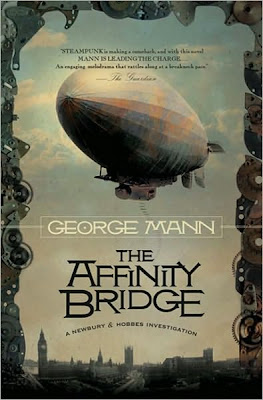Title: The Affinity Bridge
Author: George Mann
Genre: steampunk, historical fiction, mystery, sci-fi elements
Series: Newbury and Hobbes Investigations #1
Pages: 334 (paperback version)
Published: July 2008
Source: bought
Source: bought
Rating: 3.5/5
The first of Mann's "Neo-Victorian" steampunk series, The Affinity Bridge was a mostly fun, mostly enjoyable read. It certainly a very read fast for me - the pace is breakneck throughout the story and it is a fairly simply told novel. Thus, the pages and mysteries fly by with ease and I was quickly caught up in the steam-powered world of Sir Maurice Newbury, a supposed academic, and his indomitable assistant Miss Veronica Hobbes. Told in the brisk, dry typically British tone one would expect, the atmosphere of the novel is appropriate and accurate - though skewed to fit a steam-powered society at the turn of the century. Tellingly, Queen Victoria herself, the symbol of the Empire, is entwined with steam machines, utterly dependent upon them for air, unable to live without them. The Affinity Bridge also reads just as if the reader had dropped into Newbury's Museum office one day; mentions of past missions and dangers are referenced numerous times throughout the pages. Such mysterious unexplained statements reinforce the idea of Sir Maurice as a dab hand at espionage, and also subtly allude to the his hidden status as Crown Investigator.
I must admit I was a bit underwhelmed by the first third of the novel. (Though, in all fairness, I have read a lot of Gail Carriger and that is a hard steampunk act to follow.) While I liked Newbury, Veronica, and even the secondary character of Inspector Bainbridge well enough, I wasn't wowed, I sadly wasn't in love with any of them. Though they all were more than bare caricatures, none were really fully developed into three-dimensional people. Veronica has her wrongfully incapacitated sister, Newbury a certain worrying fondness for the laudanum - but a vice does not a complete personality make. Another issue I had while reading the beginnig was that the initial key mysteries (all three of them central to the main plot) are introduced within pages of another, and along with the steady fresh influx of characters, world, inventions -- it's a lot to take in at once and then try to deduce the mystery. Very much a plot-driven novel as opposed to character, it was weird to me as a reader that seemingly important and relevant plotlines would be dropped for quite a long time (75-100 pages in 330 page novel) and then be abruptly resumed later down the line.
Another issue I had was the inconsistency of the story. Veronica has a younger sister named Amelia that can see the future; her vision are always correct and always misunderstood. She cannot control them and her parents have had her restrained in a sanatorium for her "illness." It is explicitly stated by Amelia herself, "This is not something I know how to control." on page 234. And then, not a page later, on 235 when asked by her sister Veronica for help with a case, Amelia essentially wills herself into a vision. I had a large issue with that - either it is controlled or it is not, but by this far into the novel the author should know better. Another issue was Newbury himself. Don't get me wrong - I went from unsure to slightly unabashedly adoring the fellow -but no one NO ONE is going to survive two near death battles with automatons, and then jump walls and break down doors. It's even stated, "He (Newbury) could hardly believe yesterday he had been laid out, dying [...] and today he was chasing a murderer in the streets." [p. 258] Not to mention the wall hopping, door breaking, TRAIN JUMPING that ensues whilst chasing said murderer down the streets. You know who else can't believe it, Newbury? Me. I can't. Any chance at credibility ended there and I just went for the fun of it.
Veronica, one of the VERY few female characters, was a pleasant surprise for such a male-dominated book. Unlike a typical Victorian woman, Miss Hobbes is stubborn, willful and utterly unafraid to do what needs doing - even if her skirt hem gets dirty. Her counterpart, Sir Maurice is more steadfast and reserved, more alike the stereotypes of his day than his assistant. His gentlemanly reserve and her forwardness create a nice dynamic between the two, though one typically reversed. What I found most interesting about these two characters were their contradictions: Hobbes, the forward-thinking progressive is against steam-machines and automatons. Newbury, who by rights should be set in his old stodgy (nearly forty-year-old) ways appreciates innovation and change. The reversal and differences of both their expected personal attitudes and assumed views on steamtechnology struck a delicate and fine-tuned balance: the reader is never sure how far to trust the automata and the technology. The disparate views and attitudes also add to the ever-so-slight blink-and-you'll-miss-it romantic tension between the two leads.





What an awesome review! Am a new follower :) by the way, love the tagline!
ReplyDeletehttp://www.book-spark.blogspot.com/
Doesn't sound like my kind of book, but great review of it. =]
ReplyDelete-Michael
thebookshelfreview.blogspot.com
thanks, ana! I've popped over and followed you!
ReplyDeleteMichael: thanks! And the same, I'm now following you. Thanks for the visits and kind words :D
I"m on my first ever steampunk novel. Still trying to get used to the world. :)
ReplyDeleteOoooh! Which book did you pick?! I'm excited for you lol
ReplyDeleteThanks for sharing this review. I like steampunk and have especially enjoyed the Sci Fi romance and now steampunk novels by Pauline Baird Jones. She has wonderfully strong characters, male and female, kicking action and snarky humor.
ReplyDeleteI like Carriger's series too for the same elements. :-)
Ooh, thanks for the mention of a new author, I'll have to google her books! That definitely sounds like a recipe for a book I'd love!
ReplyDelete